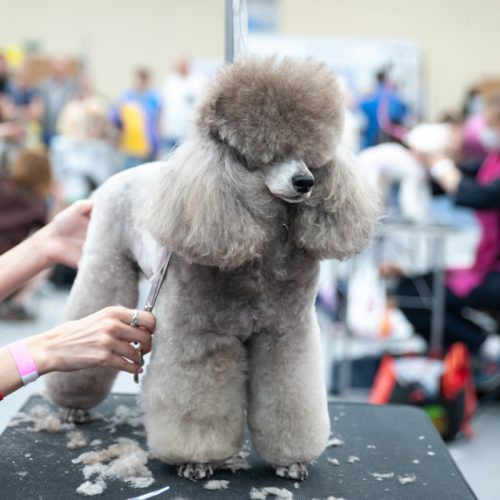
From the onset, we issue an invitation to groomers and Poodle people to share how they groom a Poodle for the show ring because this post is about a “casual” trim, and a hugely simplistic one, at that. What both trims have in common, however, is using “landmarks” on the dog to know where to hand scissor, where to shave, and where to set pattern lines. Groomers preparing a dog for the ring will accentuate the dog’s attributes, and aim to minimize faults or weaknesses, and that takes a good eye, and no small amount of skill. Hair left long on the dog should look like a puff of cotton candy, and cotton candy doesn’t have clipper or scissors marks on it. That said, the dog’s silhouette shouldn’t be as “puffy” as cotton candy, but rather smooth and neat, and that’s harder and more time consuming to pull off than one might think.
We may not present this next section in the order a groomer would do it, and that’s why we’re inviting comments from people who know what they’re doing with a Poodle coat. Still, we want to impart to our readers who are not Poodle people, or maybe not even dog people that even a pet trim on a Poodle isn’t arbitrary. The pom pom at the end of the tail, for instance is trimmed to be neat and rounded, but when the dog holds her tail up, the top of it should be about level with the dog’s skull.
At the other end, a groomer will use the dog’s shoulder muscle to set the pattern line. There is blending and scissoring on the legs, and if “cuffs” are left on the dog’s feet, they should just meet the top of the knuckles. At the back end, the thigh muscle is used to set the pattern line, especially to show off a well assembled rear. Moving downwards, the lowest point of the pattern should be at the bend.
Trimming the head and lower muzzle area starts by establishing a line from the eye to the ear and imagining a “V” starting at the dog’s larynx (or Adam’s apple) and ending at the front of each ear fold. Points on the dog’s skull are used to set the topknot, and those clipped lines on the sides of the face help establish the top knot because it will parallel the zygomatic arch – or, for lack of a better way of describing it, the top of the dog’s cheekbone. The height of the topknot is ideally the distance between the outside corners of the dog’s eyes. As for the throat, the dog’s nose end can serve as a reference point on where to set the depth of a v-shaped neckline before clippering.
There is a lot of nuance in grooming a Poodle coat, and the last few paragraphs have fairly skimmed over the topic. We simply wanted to touch upon the talent and skill it takes to create the look of a show Poodle, and to underscore the knowledge that groomers have of a dog’s anatomy. Our photo also isn’t reflective of what we’ve described but simply illustrates a Poodle being scissored.
Image: © WildStrawberry_magic | Dreamstime.com

Poodle trims are all about balance show trim or pet trim ..yes we have “land marks” but those change when you attempt the balance.. for instance you set the bracelets by trimming in the back ones first.. the front is usually the same height.. but occasionally a dog may look more balanced if leggy with the front bracelet a little higher.. the last rib is often used for placement of the Jacket..but there are variables! If a dog has a little too much loin, the jacket at the last rib may not be balanced.. if a poodle is very short backed there may not be enough room to balance the rosettes with the jacket on the last rib..more true in the 2 smaller sizes. Beauty and balance is in the eye of the viewer and changing a line can make or break the whole trim..as the modified conti gains popularity we will find more honest dogs with little hair to hide imperfections!
Really helpful comment, Vickie, thanks!